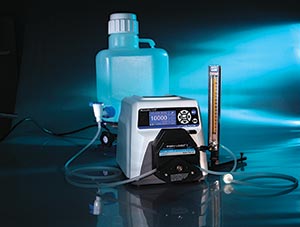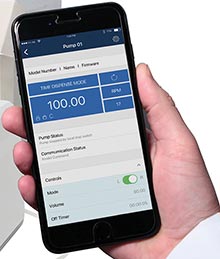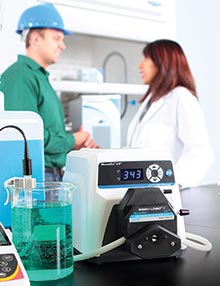Remote Peristaltic Pump Monitoring
Remote Peristaltic Pump Monitoring through the IoT Increases Productivity and Reduces Costs in R&D and Pilot Plant Operations
 Today’s research and development is becoming more demanding. Companies need to find ways to increase their throughput without corresponding budget increases. At the same time, samples are more valuable than ever, so loss of a single batch can cost tens of thousands of dollars. R&D managers have been traditionally faced with two choices: leave their experiments running overnight unattended and risk loss of a valuable sample, or stop their work at the end of the day losing valuable productivity. Advances in remote monitoring through the Internet of things (IoT) have eliminated the need for a physical presence in fluid handling research and development, giving researchers the ability to remotely achieve much of the same monitoring they need in their workflow—whether that be preparation, fermentation, harvesting, or purification.
Today’s research and development is becoming more demanding. Companies need to find ways to increase their throughput without corresponding budget increases. At the same time, samples are more valuable than ever, so loss of a single batch can cost tens of thousands of dollars. R&D managers have been traditionally faced with two choices: leave their experiments running overnight unattended and risk loss of a valuable sample, or stop their work at the end of the day losing valuable productivity. Advances in remote monitoring through the Internet of things (IoT) have eliminated the need for a physical presence in fluid handling research and development, giving researchers the ability to remotely achieve much of the same monitoring they need in their workflow—whether that be preparation, fermentation, harvesting, or purification.
Remote monitoring, increasingly seen in pharmaceutical processing operations, can be equally, if not more, beneficial for R&D departments tasked with fluid handling experiments or pilot testing. Applying remote monitoring to peristaltic pumps can positively impact departments who are tasked with fluid handling 24/7 but don’t have the staff to monitor the pumps. This opportunity to complete the R&D phase and move quickly through the pilot process can reduce the time to market for a new product and lower the cost of bringing a new product to market.
Cloud-based remote monitoring
 With the growth in Internet connectivity, peristaltic pumps and other fluid handling instruments can now be monitored by way of cloud services from anywhere in the world. Fluid handling equipment is now able to send read-only indication of operational parameters and status conditions viewable through an applet on any Internet-connected device. Monitoring of these parameters and conditions can give researchers peace of mind that their experiment is running exactly how they left it upon leaving the lab or pilot plant. It also allows multitasking during longer dispensing runs as the researcher can perform other critical tasks in their workflow in other locations while being able to confirm exactly how much time is left in their dispensing run.
With the growth in Internet connectivity, peristaltic pumps and other fluid handling instruments can now be monitored by way of cloud services from anywhere in the world. Fluid handling equipment is now able to send read-only indication of operational parameters and status conditions viewable through an applet on any Internet-connected device. Monitoring of these parameters and conditions can give researchers peace of mind that their experiment is running exactly how they left it upon leaving the lab or pilot plant. It also allows multitasking during longer dispensing runs as the researcher can perform other critical tasks in their workflow in other locations while being able to confirm exactly how much time is left in their dispensing run.
Operating parameters that can be transmitted include:
- Flow characteristics: Monitor whether the peristaltic pump is operating in continuous or dispense mode, what flow rate or speed the pump is running and the cumulative flow rate pumped
- Dispense status: View the current aliquot volume setting and dispense cycles completed.
Status conditions that can be transmitted include:
- Pump motor status: Confirm whether the pump motor is running or stopped and the direction of current operation (clockwise or counterclockwise).
- Process status: Confirm that the pump head has not been accidently opened or a leak has not occurred within the process.
- Pump system status: Confirm that no error has occurred and that the pump is online and operational.
 For researchers looking for a more hands-off approach to monitoring, the monitoring interfaces can also be set up with notification rules that send alerts by email or text about certain conditions such as dispense cycle completion, leakages, equipment errors. Every second is critical with sensitive and expensive samples; immediate notification allows quick reaction that can salvage cells, media or other important products. In a perfect example of “simpler is better,” the read-only transmission of operational parameters and status conditions maintains security and confidentiality. The pump process cannot be interrupted nor can critical information about the underlying R&D be viewed by unauthorized parties. The monitoring applet is also controlled by log-in and strong passwords and then paired only with a unique serial number for the equipment, adding another layer of security against unintended viewing.
For researchers looking for a more hands-off approach to monitoring, the monitoring interfaces can also be set up with notification rules that send alerts by email or text about certain conditions such as dispense cycle completion, leakages, equipment errors. Every second is critical with sensitive and expensive samples; immediate notification allows quick reaction that can salvage cells, media or other important products. In a perfect example of “simpler is better,” the read-only transmission of operational parameters and status conditions maintains security and confidentiality. The pump process cannot be interrupted nor can critical information about the underlying R&D be viewed by unauthorized parties. The monitoring applet is also controlled by log-in and strong passwords and then paired only with a unique serial number for the equipment, adding another layer of security against unintended viewing.
Conclusion
When operating with tight budgets or constrained resources, researchers can take advantage of new connectivity capabilities. Immediate benefits include an increase in productivity and a reduction in costs within their laboratory and pilot plant fluid handling operations. This connectivity can help improve time to market and allow unattended and overnight operation, while maintaining confidence that the process is being monitored.
Bluetooth connectivity allows for a hands-off approach providing flexibility of pump placement within the research process and can emulate the plant process thereby allowing a quicker time between the R&D lab to the process floor. This technology can also add a level of safety for employees by distancing then from harmful chemicals and biologics.
Cloud-based remote monitoring allows the researcher to track extended runs for a more seamless extension through pilot-scale and into full process. Read-only data transmission ensures data security—which is and should be a concern shared by researchers and product developers.
Masterflex® now offers new connectivity options on its most popular drives in L/S and I/P sizes to provide customers with maximum control over their pumping applications. In addition to Bluetooth and cloud-based monitoring, Masterflex’s new Advanced Communication drives support Ethernet/IP communications for automated processes. Learn more about remote pump monitoring plus Masterflex L/S & I/P Drives with Advanced Networking & Communication products on our website.